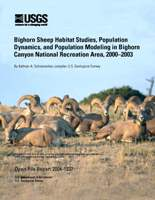Bighorn sheep habitat studies, population dynamics, and population modeling in Bighorn Canyon National Recreation Area, Wyoming and Montana, 2000-2003
Links
- Document: Report (pdf)
- Download citation as: RIS | Dublin Core
Abstract
At the request of National Park Service resource managers, we began a study in 2000 to evaluate causes for the decline of the bighorn sheep (Ovis canadensis) population inhabiting Bighorn Canyon National Recreation Area (BICA), the Pryor Mountain Wild Horse Range, and surrounding state and U.S. Forest Service lands in Montana and Wyoming. Our study consisted of radio-collaring adult rams and ewes with mortality sensors to monitor adult mortalities, tracking ewes to determine pregnancy and lambing rates, habitat assessments to determine why the population was not expanding into what had been modeled using GIS methodology as suitable bighorn sheep habitat, measuring ungulate herbaceous consumption rates and herbaceous production to determine plant responses, and aerial and boat surveys to determine bighorn sheep population range and population dynamics (Schoenecker and others, this report). Two habitat suitability models were created and conducted (Gudorf, this report; Wockner and others, this report) using different methodologies, and comparisons made between the two. Herd population dynamics were modeled using the POP-II and POP-III programs (Roelle, this report), and a reassessment of ungulate exclosures that were established 8–10 years ago was conducted (Gerhardt, this report).
The bighorn sheep population of the greater Bighorn Canyon National Recreation Area (BICA) was extirpated in the 1800s, and then reintroduced in 1973. The herd increased to a peak population of about 211 animals (Kissell and others, 1996), but then declined sharply in 1995 and 1996. Causes for the decline were unknown. Numbers have remained around 100 ± 20 animals since 1998. Previous modeling efforts determined what areas were suitable bighorn sheep habitat (Gudorf and others, 1996). We tried to determine why sheep were not using areas that were modeled as suitable or acceptable habitat, and to evaluate population dynamics of the herd.
| Publication type | Report |
|---|---|
| Publication Subtype | USGS Numbered Series |
| Title | Bighorn sheep habitat studies, population dynamics, and population modeling in Bighorn Canyon National Recreation Area, Wyoming and Montana, 2000-2003 |
| Series title | Open-File Report |
| Series number | 2004-1337 |
| DOI | 10.3133/ofr20041337 |
| Year Published | 2004 |
| Language | English |
| Publisher | U.S. Geological Survey |
| Publisher location | Reston, VA |
| Contributing office(s) | Fort Collins Science Center |
| Description | xi, 202 p. |
| Country | United States |
| Other Geospatial | Bighorn Canyon national Recreation Area |
| Online Only (Y/N) | N |
| Additional Online Files (Y/N) | N |


